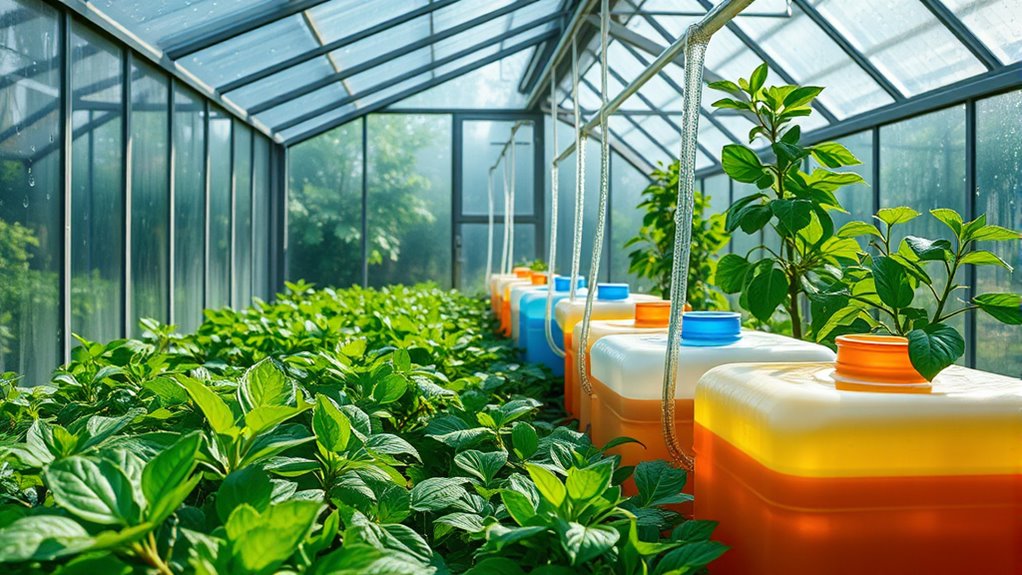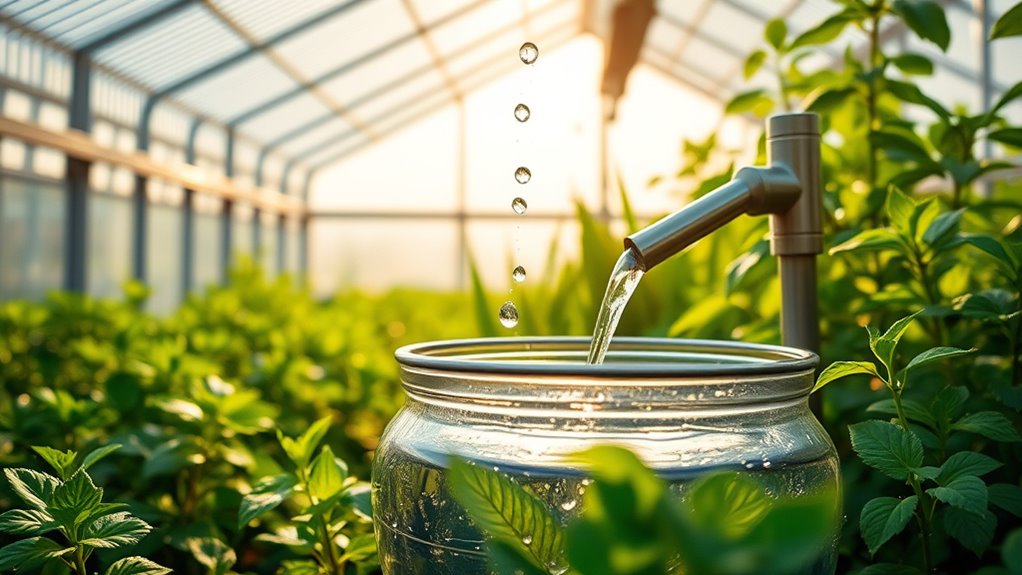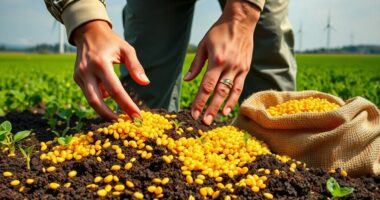Collecting rainwater in your greenhouse is a great way to eco-friendly, cost-effective, and natural watering. You can gather water from roofs using durable containers and install filters or diverters to keep debris and pollutants out. Store the water in sealed, shaded tanks to prevent algae and contamination. Regular maintenance guarantees clean, healthy water for your plants. Keep exploring to discover more tips on making the most of your rainwater harvesting system.
Key Takeaways
- Install durable, sealed rainwater collection containers with proper placement to maintain water quality.
- Use simple filtration and first-flush diverters to ensure rainwater purity for your greenhouse needs.
- Link multiple tanks for scalable storage and easy access via spigots or taps.
- Regularly clean tanks and monitor for debris or algae to keep water safe for plants.
- Rainwater provides a natural, chemical-free, mineral-rich water source that promotes healthier plant growth.

Have you ever considered how rainwater collection can benefit your greenhouse? Harvesting rainwater isn’t just an eco-friendly choice; it can considerably improve your plants’ health and reduce your reliance on municipal water sources. When you collect rainwater, you gain access to a natural, chemical-free water supply that’s often richer in beneficial minerals than tap water. But to make the most of this resource, understanding rainwater purity and storage container options is essential. Rainwater purity is essential because it determines how safe and effective the water will be for your plants. Generally, rainwater is relatively pure when it first hits your collection surface, such as a roof or gutter system, but it can pick up contaminants from debris, bird droppings, or pollutants in the air. That’s why implementing simple filtration or first-flush diverters can help improve water quality, ensuring you’re collecting as clean a resource as possible.
Considering the potential for contaminants to affect plant health, it’s important to regularly test your rainwater if possible. Choosing the right storage container options is the next step. You’ll want containers that are durable, UV-resistant, and easy to clean to prevent algae growth and mosquito breeding. Popular options include food-grade plastic tanks, which are lightweight and affordable, or more robust options like concrete or metal tanks for larger setups. Whichever you choose, make sure the containers are sealed tightly to prevent contamination and mosquito access. Placement is also key—position your tanks in shaded areas to slow algae growth and keep the water cool, preserving its quality. Additionally, consider installing a spigot or tap at the bottom of the tank for easy watering without disturbing the entire container. Some growers opt for multiple tanks linked together, creating a scalable system that can store ample rainwater for the entire growing season.
Regular maintenance is essential to keep rainwater as pure as possible. Rinse out your storage tanks periodically and check for any signs of algae or debris. If you notice any issues, drain and clean the containers thoroughly before refilling. Using rainwater in your greenhouse isn’t just about saving money—it’s about providing your plants with a cleaner, more natural water source that promotes healthier growth. By paying attention to rainwater purity and choosing the right storage options, you set yourself up for a sustainable, efficient watering system that benefits both your plants and the environment. With thoughtful planning, collecting rainwater becomes an easy, effective way to enhance your greenhouse’s productivity.
Frequently Asked Questions
How Do I Prevent Mosquito Breeding in Rainwater Tanks?
To prevent mosquito breeding in rainwater tanks, you should implement mosquito prevention measures like installing fine mesh screens on all vents and outlets. Regular rainwater treatment, such as adding larvicides or using biological controls like BTI, keeps the water mosquito-free. Also, cover your tank tightly and remove any debris or standing water around it. These steps help guarantee your rainwater remains safe and mosquito-free for your greenhouse needs.
What Is the Optimal Rainwater Storage Capacity for My Greenhouse?
You should aim for a rainwater storage capacity of at least 200 gallons to guarantee a reliable supply for your greenhouse. Opt for a tank made of durable, UV-resistant material like polyethylene or concrete. Incorporate proper rainwater filtration to keep debris and contaminants out. This setup provides enough water for your plants while minimizing maintenance needs, helping you maintain healthy, thriving greenhouse conditions year-round.
Can Rainwater Be Used for All Types of Greenhouse Plants?
Did you know that over 80% of greenhouse plants thrive on rainwater due to its high purity? You can generally use rainwater for most greenhouse plants, but some, like certain orchids or carnivorous plants, prefer specific water qualities. Always check plant compatibility and verify rainwater is free from contaminants. With proper filtration, rainwater can be a versatile and sustainable source for your entire greenhouse.
How Often Should I Clean and Maintain the Rainwater Collection System?
You should clean and maintain your rainwater collection system regularly, ideally every 3 to 6 months. Start by inspecting system components for debris, leaks, or damage, and perform rainwater testing to guarantee water quality. Clear out gutters and filters, and sanitize tanks if needed. Regular maintenance keeps your system efficient and safe for your plants, ensuring you’re always using clean, high-quality rainwater in your greenhouse.
Are There Any Legal Restrictions on Collecting Rainwater in My Area?
Did you know that over 30 states in the U.S. have specific rainwater permits? It’s crucial to check local laws to guarantee legal compliance before collecting rainwater. Some areas restrict storage or usage, while others encourage it. You should contact your local water authority or environmental agency first. This way, you avoid fines or penalties and make sure your rainwater collection practices stay within legal boundaries.
Conclusion
Collecting and using rainwater in your greenhouse is a smart, eco-friendly choice that saves money and supports sustainable gardening. Some worry about contamination, but with proper filtering and maintenance, your rainwater remains pure and safe for plants. Embracing this method reduces reliance on tap water, helping you create a more resilient, environmentally conscious greenhouse. So go ahead—start harvesting rain today and enjoy healthier plants while making a positive impact on the planet.









